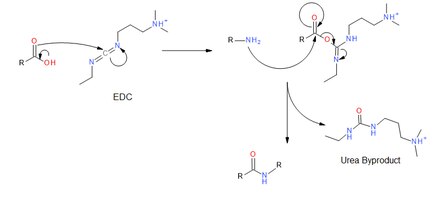1-Ethyl-3-(3-dimethylaminopropyl)carbodiimide

| |

| |
| Names | |
|---|---|
| IUPAC name
3-(Ethyliminomethyleneamino)-N,N-dimethylpropan-1-amine
| |
| Identifiers | |
| |
3D model (JSmol)
|
|
| ChemSpider | |
| ECHA InfoCard | 100.015.982 |
PubChem CID
|
|
| UNII |
|
CompTox Dashboard (EPA)
|
|
| |
| |
| Properties | |
| C8H17N3 | |
| Molar mass | 155.245 g·mol−1 |
| Hazards | |
| Safety data sheet (SDS) | External MSDS (HCl Salt) |
Except where otherwise noted, data are given for materials in their standard state (at 25 °C [77 °F], 100 kPa).
| |
1-Ethyl-3-(3-dimethylaminopropyl)carbodiimide (EDC, EDAC or EDCI) is a water-soluble carbodiimide usually handled as the hydrochloride.[1] It is typically employed in the 4.0-6.0 pH range. It is generally used as a carboxyl activating agent for the coupling of primary amines to yield amide bonds. Additionally, EDC can also be used to activate phosphate groups in order to form phosphomono-esters and phosphodiesters. Common uses for this carbodiimide include peptide synthesis, protein crosslinking to nucleic acids, but also in the preparation of immunoconjugates. EDC is often used in combination with N-hydroxysuccinimide (NHS) for the immobilisation of large biomolecules. Recent work has also used EDC to assess the structure state of uracil nucleobases in RNA.[2][3]
Preparation
EDC is commercially available. It may be prepared by coupling ethyl isocyanate to N,N-dimethylpropane-1,3-diamine to give a urea, followed by dehydration:[4]
Mechanism

EDC couples primary amines to carboxylic acids by creating an activated ester leaving group. First, the carbonyl of the acid attacks the carbodiimide of EDC, and there is a subsequent proton transfer. The primary amine then attacks the carbonyl carbon of the acid which forms a tetrahedral intermediate before collapsing and discharging the urea byproduct. The desired amide is obtained.[5]
References
- ^ Richard S. Pottorf, Peter Szeto (2001). "1-Ethyl-3-(3'-dimethylaminopropyl)carbodiimide Hydrochloride". e-EROS Encyclopedia of Reagents for Organic Synthesis. doi:10.1002/047084289X.re062.
- ^ Mitchell, D; Renda, A; Douds, C; Babitzke, P; Assmann, S; Bevilacqua, P (2019). "In vivo RNA structural probing of uracil and guanine base-pairing by 1-ethyl-3-(3-dimethylaminopropyl)carbodiimide (EDC)". RNA. 25 (1): 147-157. doi:10.1261/rna.067868.118. PMC 6298566. PMID 30341176.
- ^ Wang, PY; Sexton, AN; Culligan, WJ; Simon, MD (2019). "Carbodiimide reagents for the chemical probing of RNA structure in cells". RNA. 25 (1): 135–146. doi:10.1261/rna.067561.118. PMC 6298570. PMID 30389828.
- ^ Sheehan, John; Cruickshank, Philip; Boshart, Gregory (1961). "A Convenient Synthesis of Water-Soluble Carbodiimides". J. Org. Chem. 26 (7): 2525. doi:10.1021/jo01351a600.
- ^ "Carbodiimide Crosslinker Chemistry - US". www.thermofisher.com. Retrieved 2019-05-10.
Further reading
- López-Alonso, JP; Diez-Garcia, F; Font, J; Ribó, M; Vilanova, M; Scholtz, JM; González, C; Vottariello, F; Gotte, G; Libonati, M; Laurents, DV (2009). "Carbodiimide EDC Induces Cross-Links That Stabilize RNase A C-dimer against Dissociation: EDC Adducts Can Affect Protein Net Charge, Conformation and Activity". Bioconjug. Chem. 20 (8): 1459. doi:10.1021/bc9001486.
- Nakajima, N; Ikada, Y (1995). "Mechanism of Amide Formation by Carbodiimide for Bioconjugation in Aqueous Media". Bioconjug. Chem. 6: 123. doi:10.1021/bc00031a015.
External links
- EDCI coupling - Synthetic protocols from organic-reaction.com

